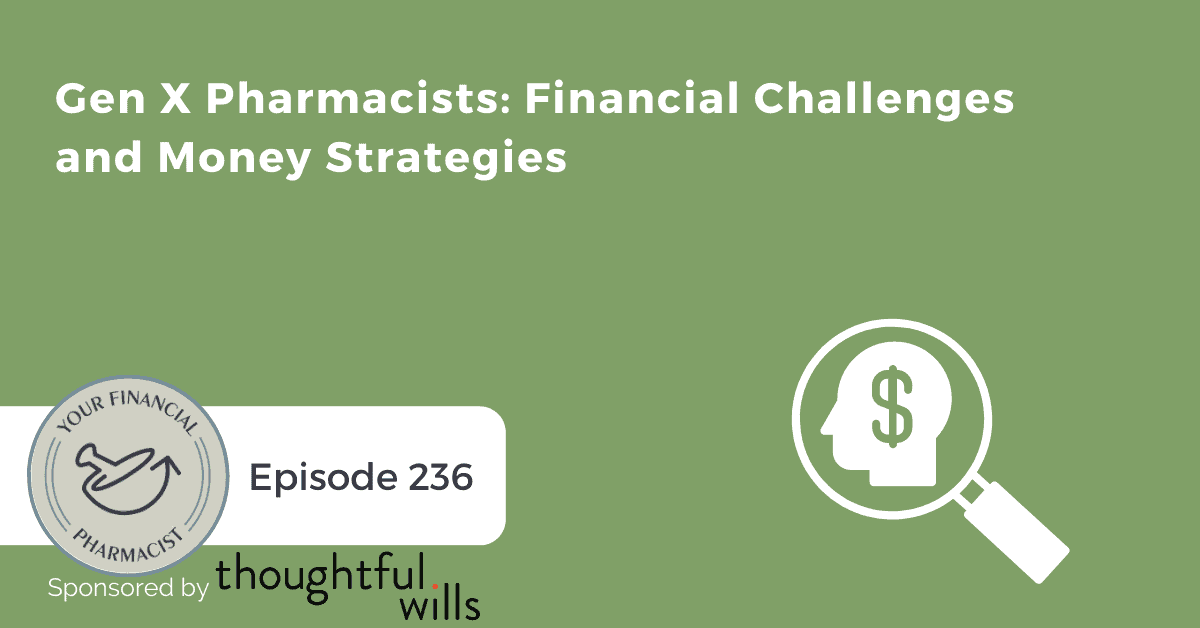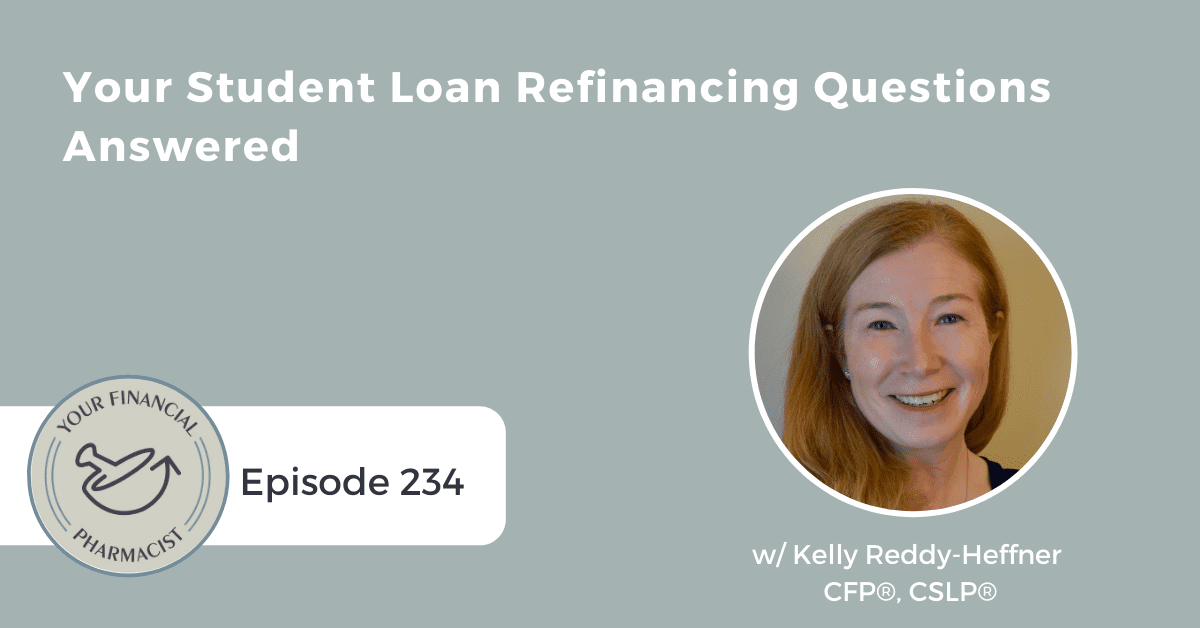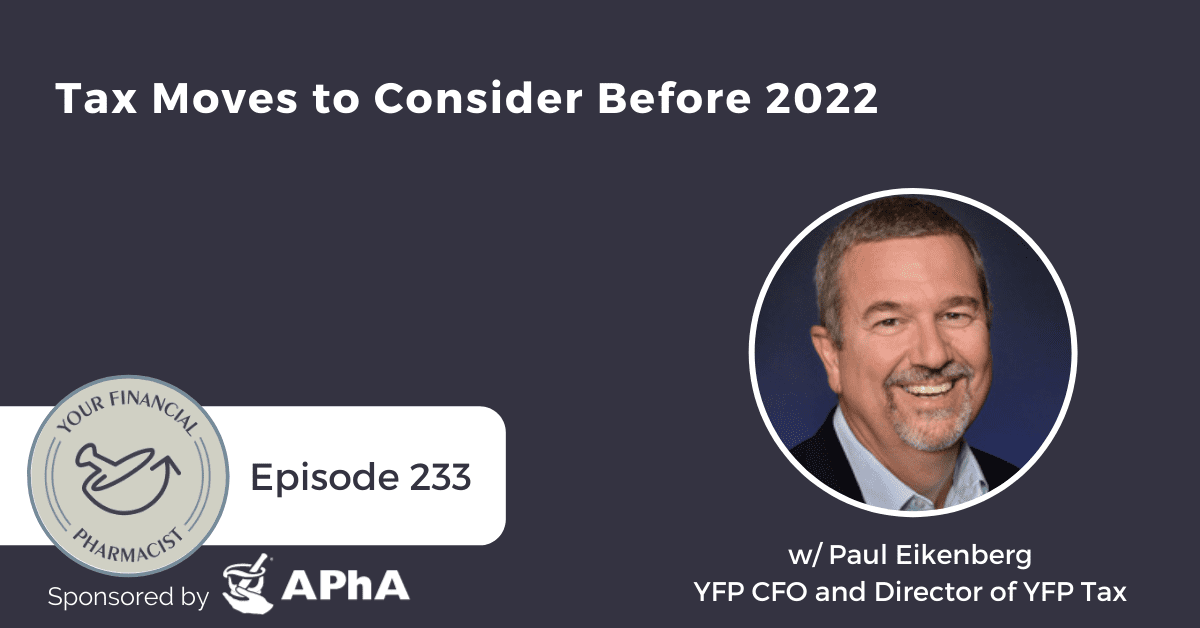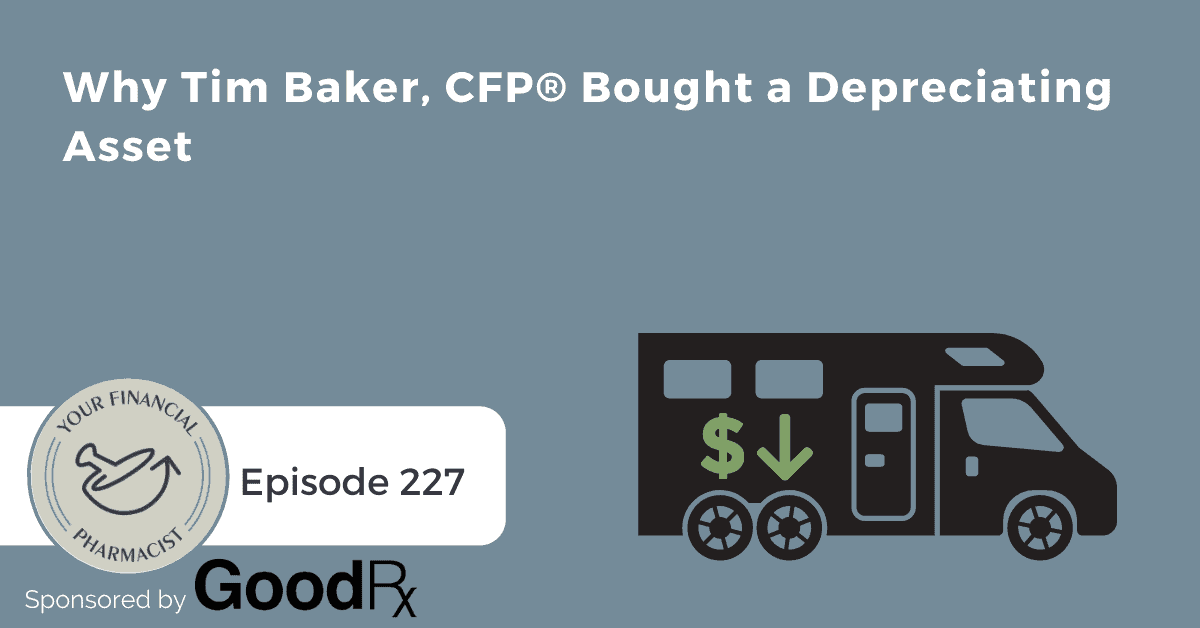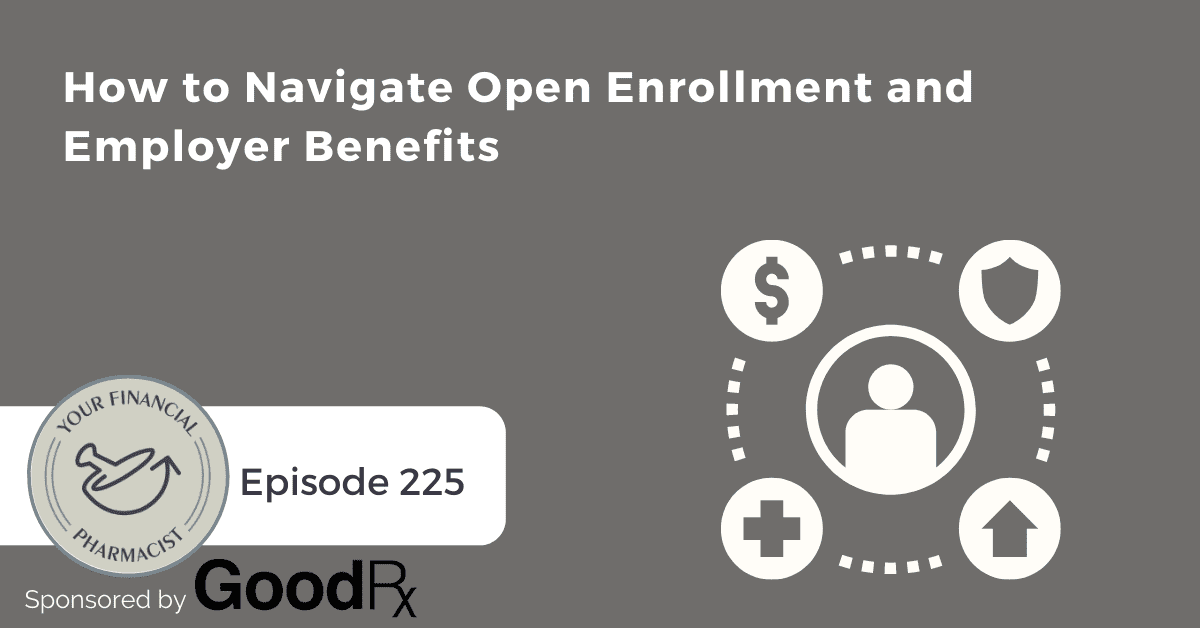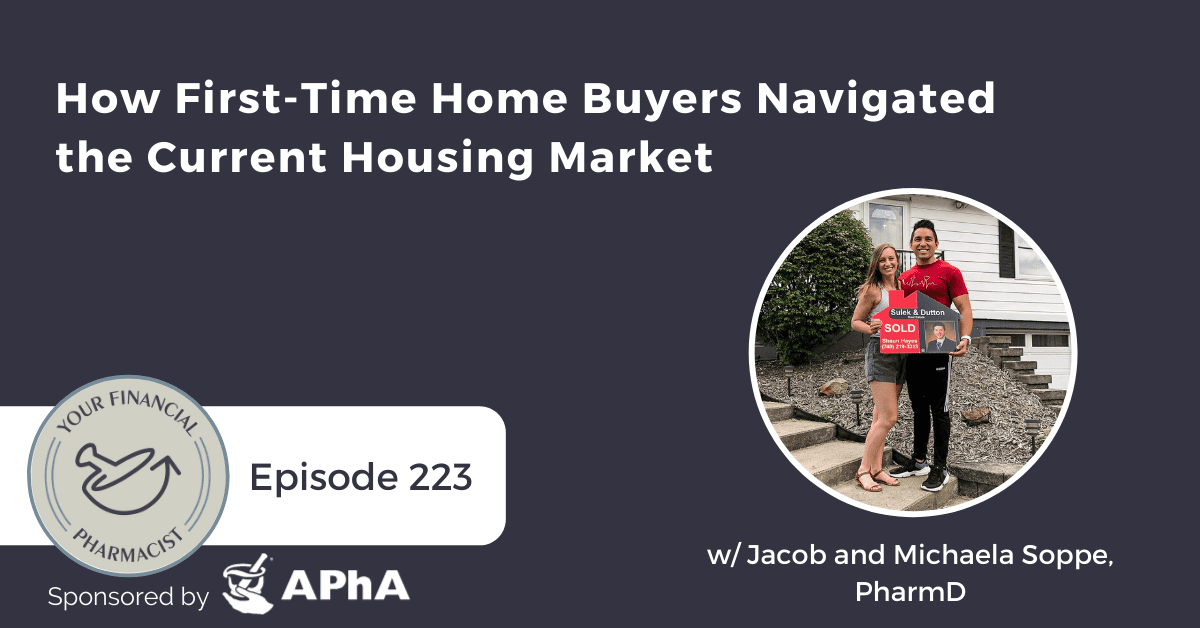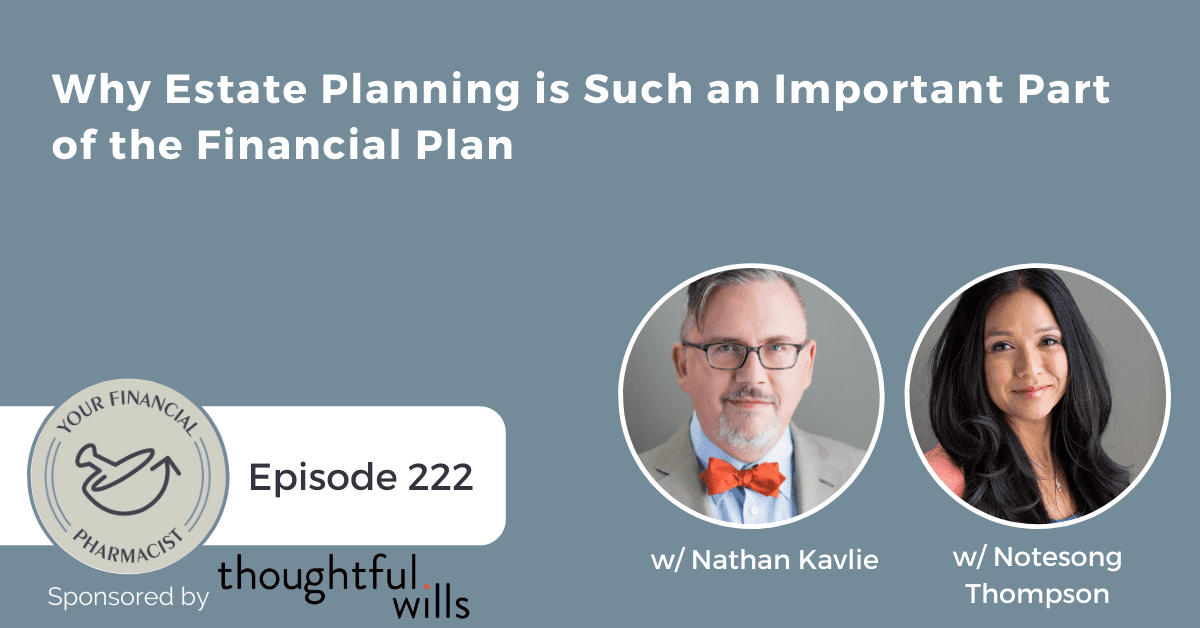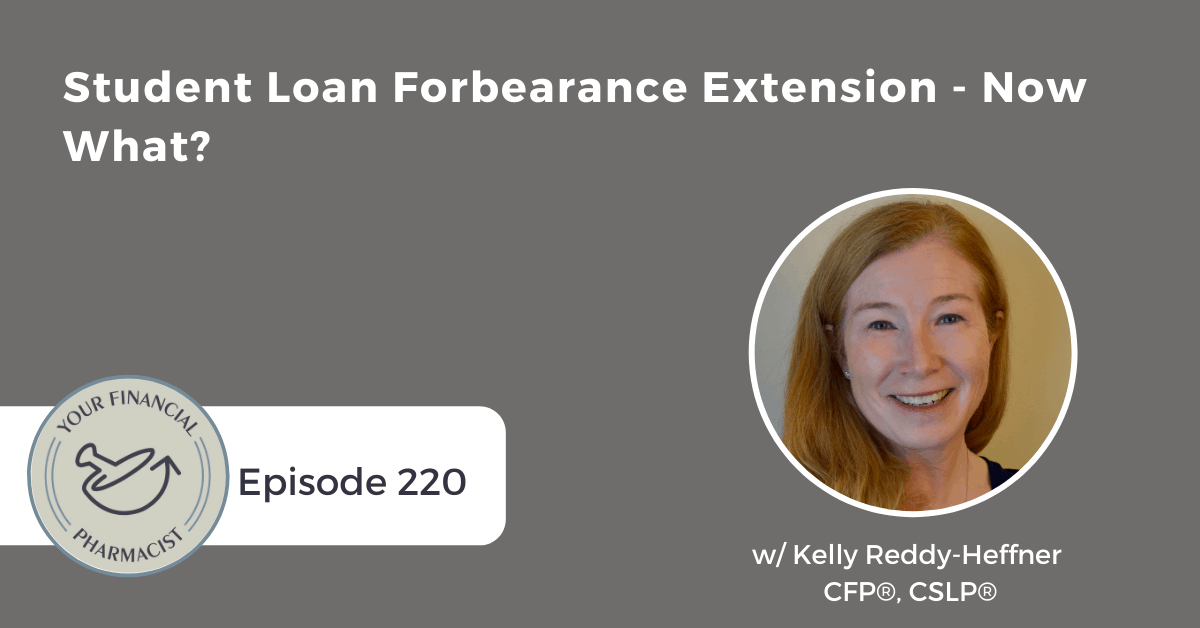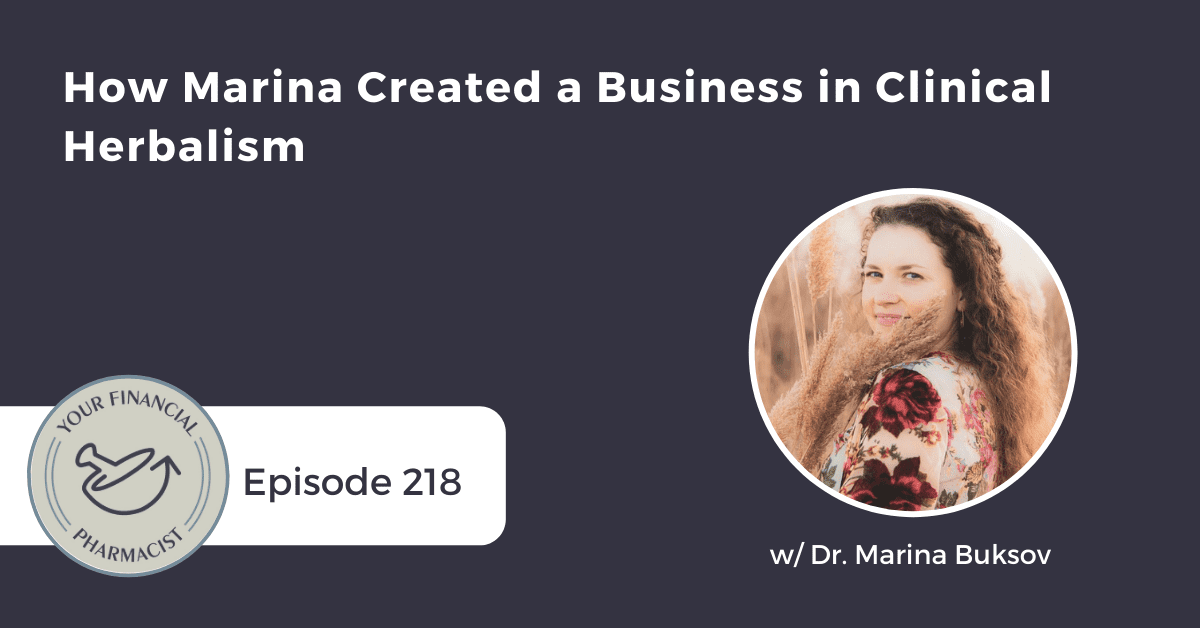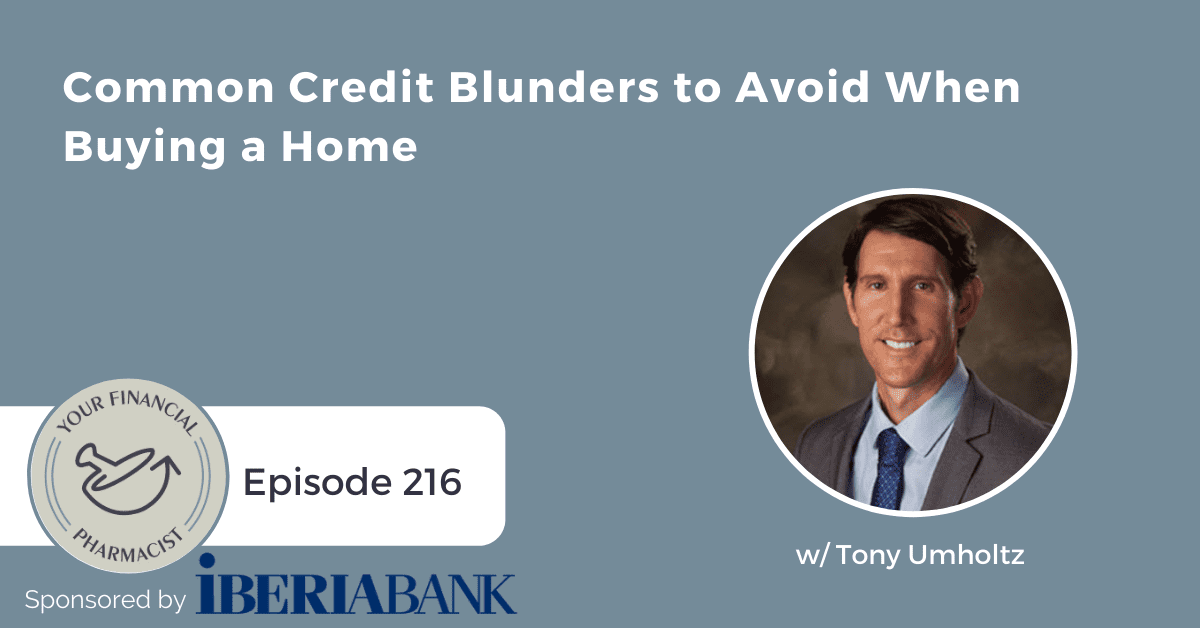Gen X Pharmacists: Financial Challenges and Money Strategies
On today’s episode, sponsored by Thoughtful Wills, Tim Baker talks through the unique financial needs and considerations of Generation X.
Episode Summary
Often referred to as the sandwich generation, Gen X is a big group of people that’s often set on the sidelines when compared to Gen Y, the millennial generation, and baby boomers. Financial planning can be hard enough by itself, but supporting your young (or not-so-young) children often at the same time as aging parents, all while trying to save for retirement, creates a unique strain on finances that requires some specific financial planning! Today on the YFP Podcast, Tim Ulbrich is here with YFP co-founder, co-owner, and director of financial planning, Tim Baker, to talk through the financial needs and considerations of our Generation X pharmacy colleagues who are well beyond the new practitioner phase, but perhaps not yet at that traditional retirement age. We talk through why this generation has some unique financial challenges and touch on how to tackle the pessimism and inertia that often comes with changing or leaving your financial planning too late. We discuss the challenges this generation face, how their debt position and accrued retirement savings compare to other generations, and some strategies to chart a successful path to independence and stability, despite the tough economic hand dealt in their lifetimes. This episode may focus on a specific age group, but all listeners will hear valuable advice and insights that would benefit anyone!
Key Points From This Episode
- An introduction to today’s topic of Gen X; the sandwich generation.
- How Gen Xers are often providing for their parents, plus a young child or a child over 18.
- How these financial expectations are often overlooked or pushed to the side.
- We talk about average incomes, the rising cost of education, and what their debt load is.
- The impact of the ups and downs in the last few years on their financial mindsets.
- How Gen X wants stability but might not have the financial plan or means to get it.
- You can take out education loans for your kids, you can’t get retirement loans.
- Hear how Tim Baker follows the one-third plan and a reminder of what that is.
- Relying on the act of planning, versus having a plan.
- Some important questions Gen Xers can ask themselves to get financially stable.
- Making sure you’re not on autopilot, particularly in your peak earning years.
- Tackling the fear and inertia of having left it so late in life to start saving and planning.
- Having empathy for Gen X needing different priorities from the previous generation.
- That Gen X really wasn’t dealt a great hand economically, but the problems are fixable.
- Reigniting the vision and finding the motivation to do things differently.
- Speaking about the lack of confidence in social security for future retirement.
- Tim shares a great exercise you can do to check your retirement age and benefits!
- We discuss the shifting dynamics of generations and the transfer of wealth.
- Some parting words of encouragement from us here at the YFP team!
Highlights
“[Gen X] is a generation that probably has some of the most important, or probably the most urgent needs in terms of their finances and financial planning.” — Tim Baker, CFP [0:04:34]
“39% feel of Gen Xers feel that they’ll never have as secure a financial life as their parents’ generation. As parents, you always want your kids to have a better upbringing.” — Tim Baker, CFP [0:09:26]
“What can you do for your kids? What do you want to do for your kids in terms of an education plan? At the end of the day, your retirement should take precedence, because you can’t take retirement loans. You can take education loans.” — Tim Baker, CFP [0:15:17]
“If I’m a Gen Xer and I’m 50, and I know that I have a decade left if I want to retire by 60, you can do a lot in 10 years. You can.” — Tim Baker, CFP [0:25:29]
Links Mentioned in Today’s Episode
- Create a Comprehensive Estate Plan with Thoughtful Wills
- The Your Financial Pharmacist Podcast
- YFP Planning: Financial Planning for Pharmacists
- Mom and Dad, We Need to Talk: How to Have Essential Conversations with Your Parents About Their Finances by Cameron Huddleston
- YFP 108: How to Effectively Talk with Mom & Dad About Their Finances
- YFP 195: How to Save for Your Child’s Education
- 5 Interesting Facts About Generation X: Financial burdens, obligations make saving challenging by Lynnette Khalfani-Cox
- Meet the typical Gen Xer, America’s ‘forgotten middle child’ who earns more than everyone else but has the most debt at $136,000 by Hillary Hoffower and Andy Kiersz
- For Gen X, retirement both beckons and threatens during the pandemic by Mark Dolliver
- Focus on Generation X, Analysis of Gen X participants reveals important considerations for plan sponsors and advisors
- Social Security Benefits Calculators
- Your Financial Pharmacist Disclaimer and Disclosures
Episode Transcript
[INTRODUCTION]
[00:00:00] TU: Hey, everybody. Tim Ulbrich here. Thank you for listening to the YFP Podcast, where each week we strive to inspire and encourage you on your path towards achieving financial freedom. This week, I had a chance to sit down with YFP co-founder, co-owner and director of financial planning, Tim Baker, to talk through the financial needs and considerations of Generation X; those born between the mid-60s and early 80s, falling between the baby boomers and the millennials. That would be our pharmacy colleagues well beyond the new practitioner phase, but perhaps not yet at that traditional retirement age.
Whether you are a student pharmacist, or a new practitioner anticipating some of the financial opportunities and challenges that may face you in the future, or you’re a Gen X pharmacist listening, my hope is that you’ll have something to take away and apply to your own personal situation.
On the show, Tim Baker and I talked through why this generation has some unique financial challenges, and is often referred to as the sandwich generation. We discuss the challenge this generation faces and the balance taking care of themselves, their children, perhaps, as well as their parents, how their debt position and accrued retirement savings compares to other generations, as well as some strategies for a Gen X pharmacist to chart a successful path boards, despite some of those challenges that they may be facing.
As we wrap up another year of the show and are knee-deep into the planning for 2022, I want to say thank you to the YFP community for entrusting us with your time, by listening to the show. We don’t take for granted your support and encouragement of the work that we’re doing at YFP, to help pharmacists on their path towards achieving financial freedom.
Also, a big shout out to YFP members Caitlin Boyle and Rose Mercado for the engine behind making them YFP podcasts a reality each week. Caitlin and Rose, your contributions to the team and the YFP community are truly appreciated. Okay, let’s hear it from today’s sponsor, and then we’ll jump into my conversation with Tim Baker.
[SPONSOR MESSAGE]
[00:02:00] TU: This week’s episode of Your Financial Pharmacist Podcast is sponsored by Thoughtful Wills. Let’s take a minute to hear from Co-Founder, Nathan.
[00:02:08] NK: My name is Nathan Kavlee, and I’m one of the founders of Thoughtful Wills. Our law firm spends a lot of time thinking about the process of estate planning. There’s no way we can get around the yuck of death. Instead, we focus on being lawyers that you’ll actually enjoy working with. We pride ourselves on being approachable. Then, we take the extra time to draft documents that are actually understandable. Then we pair that with technology to make the process cheaper and more convenient. Please visit our website thoughtfulwills.com/yfp and poke around. Then book a meeting with us, please. We are genuinely excited to chat with you.
[INTERVIEW]
[00:02:46] TU: Tim, excited to have you back in the mic.
[00:02:48] TB: Yeah. Good to be back for a full episode, Tim. How’s it going?
[00:02:52] TU: It is going. We are just a couple days away from the New Year, and hard to believe that we’ve had another year of the podcast, another year of the growth of the YFP community, growth of the team at YFP, and so much to be grateful for as we roll the calendar into 2022, and excited for what lies ahead as well.
[00:03:13] TB: Yeah. It’s been a year of change, I think, with everything that’s going on. I think, all for the good. I’m excited for what 2022 brings in. Hopefully, we can continue to crawl out of this pandemic, and we don’t have too many more of the variants that are shutting things down. I’m excited for what’s ahead, though.
[00:03:33] TU: We’re going to start to dig into this topic, one that we haven’t covered in great detail before. Today, we’re talking about the financial needs and considerations of Gen X pharmacists. I think, it’s worth noting that we’re talking about generations, we’re obviously talking in general generality and general form. Certainly, unique situations are going to apply here. Tell us a little bit more about why we want to delve more into this this topic on the podcast as we look at financial needs and considerations of Gen X?
[00:04:02] TB: Yeah. I think, just like the generation, it’s kind of like the forgotten middle child. When we’re talking about Gen X, we’re talking about a group of about 65 million people that are born between 1965 and 1980. The youngest is in their early 40s, turned 41 this year, and then the oldest being in their mid-50s, turning 56 this year. It’s a big group of people that it’s often set on the sidelines when compared to Gen Y and the millennial generation, or baby boomers.
I think, it’s a generation that probably has some of the most important, or somewhat, probably the most urgent need in terms of their finances and financial planning. This generation, it’s called the latchkey generation. A lot of kids after school would go to this latchkey programs. I’ve also heard him them called, Oregon Trail generation, the Trapper Keeper generation. I have a personal affinity.
[00:04:59] TU: Oregon Trail. It’s good.
[00:05:00] TB: Yeah. I’m technically part of the Gen Y. I’m an I’m an older Gen Y-millennial, born in ’82. Well, my brother was born 80, so he’s a young Gen Xer at the end of ’80. I see both, I feel I fit in between both generations, and I see both sides of it. It’s also often called the sandwich generation, which really entails a Gen Xer taking care of not only themselves, but their kids that are coming of age, but also aging parents. 47% [inaudible 00:05:33], 47% of adults in their 40s and 50s have a parent over age 65, and are either raising a young child, or providing financial support to a young child over 18.
You can imagine, Tim. Before I had kids, I’m like, “Man, I can barely take care of myself. How can I take care of another human being?” That’s what’s going on here as their adult, and as they got to take care of themselves, and then they have to basically take care of parents, and then their kids that are coming of age. It’s a daunting task. Unfortunately, there’s a lot of – I feel like, there’s a lot of negativity and cynicism, not just even around the coverage of Gen X, but even inside of Gen X, as you see some of the things that they experience over time. It’s something that I think needs to be talked about more, because I feel all of the press, all of the language is either for baby boomers, or this Gen Y generation, baby boomers – Gen X are just left on the side.
[00:06:36] TU: It’s really true. It’s something that I’ve observed, since we’re prepping for this episode, is when you hear generational news that’s out there, the millennials get a lot of love. Gen Z gets a lot of attention, baby boomers. This concept of a sandwich generation, a generation that’s often overlooked but has some significant things that they’re facing financially. Hopefully, some things that we can turn into opportunities may get overlooked in terms of the stress and the burden that that group is carrying.
You’ve laid the foundation, Tim, in terms of Gen X. So, people born approximately 1965 to 1980. We’re looking at early 40s to mid-50s, known as the sandwich generation, and between millennials and baby boomers. That concept of being caught between taking care of their children, as well as aging parents.
I just talked with a prospective client earlier this week, young family, two kids under the age of four, going through their own student loan, debt repayment scenario, trying to get investing off the ground, and get some early momentum there. Then also, the prospect of potentially having to take care of their elderly parents in the near future. That’s weighty, right? I think, you and I would both argue from individual experiences, as well as the pharmacists that we talk with all across the country, that financial planning can be hard enough in and of itself, without having to think about an additional burden that might be placed upon something like, having to take care for elderly parents.
[00:07:58] TB: Yeah. I think, this is the start of many sandwich generations, unfortunately. Maybe not unfortunately, but I know, a lot of our Gen Y clients are, they have a bucket of money that’s just like, “Hey, my parents either got me here because they immigrated here.” Or, that’s what our culture says, “My job is to is to make money and take care. I am my parents’ retirement plan.” That’s not just related to Gen X, I think, that’s going to be a common theme in Gen Y and Gen Z.
I think, the difference is that the year – it’s upon us already for Gen X. They’re already doing it. Probably, haven’t really planned for it. The good part about Gen X is that they’re approaching their peak earning years. On average, they make more money. I think, I think the average household income was something like, in the $130,000s or something like that. On average, they make a lot more than baby boomers who are winding down, or they’re already retired. Then Gen Ys are still – and we know in pharmacy, it’s a little bit different.
Average net worth for – if you’re if you’re clocking this average net worth, I think I saw a number out there, it was about a $168,000. That’s not a lot, especially if you’re thinking you only have 10, or 20 years left to work, if you’re going to retire in your 60s, that type of thing. I think, the one thing that came out to me when I was looking at this was, 39% feel of Gen Xers feel that they’ll never have a secure as a financial life as their parents’ generation. Which, and that’s one thing is like, as parents, you always want your kids to have a better upbringing.
I think, the other thing that is interesting about Gen X, as you’re looking at the data, and just some of the editorial comments, they are sandwich in terms of – they have a lot of the consumerism that baby boomers had. It was like, Gen X spends more than any other generation in terms of consumer goods, but they also got hit with the rising cost of education. Now not to the degree where pharmacists are coming out today. We have charts where the income was pretty close to what the debt levels are for a PharmD, and then the PharmD debt just raced by the income.
I think, to a lesser degree that the debt, and obviously, they’ve had years, a decade, or more of paying, 15 years of paying off student loans. I think, the biggest portion of what they’re seeing in terms of debt loads are coming in the form of mortgages, credit cards, auto loans. But also, still having those student loans.
Unfortunately, Tim, we see a lot of pharmacists that are in this generation that haven’t put that big of a dent into their student loans at all, because of I think, the construct of “Hey, you just pay the least amount and you drag it on forever.” Unfortunately, you’re left with a large sum, even 10, 15 years into your career, 20 years of your career, unfortunately.
[00:11:07] TU: Tim, one of the things I was thinking about recently, I graduated in 08, was that – 13 years ago or so, that was shortly after the requirement to the PharmD. This group, most of them, unless they went back and got – PharmD would have been in the BS period, before the PharmD was required. One of the things I’ve been reflecting upon is that I graduated in 08, obviously, the recession of 08 was what it was. I was in residency making $31,000 and didn’t have a whole lot of focus, or attention on savings. I didn’t really feel that very much, even though I observed it and lived in it.
All I know, is what has been a pretty wild market ever since then, that’s only been on the up and up overall, obviously, outside of some dips and so forth in between. I often think like, “Man, what kind of overconfidence has that led?” Potentially, not only my situation, but others that are in that window that have graduated in the last 13 years and have not experienced a significant downturn and has had that real impact, where you’ve accumulated savings, and you’re like, “Oh, my gosh. This is real.” I see the dip.
We look at this generation, they’ve been through the dot-com bubble. They’ve been through the 08 financial crisis, and they’ve been through what has been the wild, last couple years on the market, since the beginning of the pandemic, in terms of the ups and downs, and even within a given week, ups and downs. What impact do you suspect that has had in terms of their approach to savings and investments?
[00:12:35] TB: Yeah. I think, it’s had a great impact. I think, it was often documented that a lot of Gen Xers were very, very much educated, but underemployed, especially dot-com. Talk about swings of wealth in markets in dotcom. Then, the subprime mortgage crisis. I think, it’s led to a lot of asceticism, and a lot of the – some of the rhetoric that you see.
I guess, to bring my point full circle, what I was trying to compare to go back to that real quick. Baby boomers, no student loan issues there, but spent and had mortgages and things, car loans and things like that, credit card debt. I think, notoriously not having been great about saving for retirement, and I think, so security’s going to definitely help them. I think, Gen Y have been more adverse to home buying and taking on a big mortgage, and less consumer debt.
Whereas that, with Gen X, you’re seeing the ugly on both sides. You’re seeing the student loans, but you’re also seeing some of the other – that other debt it’s piled on. I think, with regard to investments, I think, that I saw a stat that Gen Xers, they’re thinking, “Yeah, we probably should be –” I think, the number was like, “We’ve probably should be saving 11%.” It’s probably closer to 20%, where they’re at in their career, if you count all of the things that you should be putting in to retirement. I think on average, they’re saving about 9%.
I think, some of the things that you’re seeing that baby boomers are working more into retirement and they don’t have confidence in their money lasting, I think, you’re going to see that compound with Gen X, unfortunately. I think, one of the things that often will buoy the Gen Xers is, as that wealth generation or wealth transfer happens, so baby boomers dying off, you’re going to start to see windfalls that are going to fix some of the ills, unfortunately, that happen.
It’s having a plan for that, and having a plan for that windfall. Gen X wants stability, but they’re not necessarily doing a lot to help their financial future. I think, what they’re just trying to do is get through the day in terms of like, “Hey, I have to take care of myself, my parents.” Then, I’m also looking at, and the whole – we can have a whole other discussion just about education and sending your kids to college, and not experience – Sometimes that, your own experience can color that for your kid. You have some people that are like, “I never want my kids to have an ounce of student loans.”
Or some people would say like, “Hey, I had to deal with it. They have to, too.” There’s no right or wrong answer, but it’s really cutting through that and understanding, what can you do for your kids? What do you want to do for your kids in terms of education plan? At the end of the day, your retirement should take precedence, because you can’t take retirement loans. You can take education loans, and hopefully, they start to figure out how to make this a little bit better, which again, that doesn’t necessarily help. It might help our kids, Tim, in the future, but it’s not going to help Gen Xers whose kids are in college, or approaching that age right now.
[00:15:43] TU: Yeah. Jess and I were just talking about that the other night, of really fighting against some of that gut and emotional reaction of wanting to over – potentially, over-contribute on the college side at the expense of other things, because of the pain we felt in our own journey, and how front and center that is.
[00:15:58] TB: Well, and I just got an email from Ohio529. They’re like, “Hey, if you put this much in, you can max out your $4,000.” Yeah. I’m like, “All right, well, we have this plan” but I’m torn to say like, “Okay. How can I get that just for the tax benefit?” Again, I think, people sometimes do things for the good of the taxes, or at the detriment of their financial plan. I mean, it’s never a bad thing to, I think, save for the future expense that hopefully will be there in the form of college.
At the same time, I had to take a step back and say, well, this is not really what Shane and I talked about in terms of our – what we want to do. And we follow that that one-third plan, which I think we’ve outlined in previous episodes of, one-third is going to come from our – the 529s that we’re saving. One-third is going to come from hopefully, that’s something I can cashflow, as our kids are in college. That present income in the future, if that makes sense. Then one-third from hopefully, scholarships, grants, and then last but not least, loan.
That’s ours. Again, at the end of the day, we’re making sure that we’re trying to fill that retirement bucket, because we want options. We went options as we approach retirement to say, “Okay, we want to work until this, or not have to work, or whatever.” To me, that’s something that the Gen X generation is also dealing with. I think to, again, it’s more into a heightened degree. One, because I think resources are scarce. You’re just dividing up between many more people, because typically, bigger households, and then we talked about again, taking care of parents and things like that. Yeah, I mean, it goes back to relying on the act of planning, versus having a plan. I think, that’s definitely something that Gen Xers should look to do if they’re grappling with all these different issues.
[00:17:53] TU: Yeah. I think, as we’ve talked about many times on the show, and something I know, we both worked through personally, and I sent it in the individuals that we talked to that are considering coming onboard as clients of YFP Planning. Sometimes there’s just so much emotional stress that we carry around related to financial planning, because of all of these things that are swirling in our mind.
We’ve talked about, many of them here is really, to Gen X in terms of debt that might be hanging around, thinking about the college for kids, or grandkids, caring for elderly parents might behind on retirement. Should I be thinking about diversifying other revenue streams? The list goes on and on. So much value from my perspective of the planning process, and what you’ve done, even with Jess and I is, “Let’s get all of these out of our head, onto paper. Let’s talk through them, let’s prioritize them, let’s beat them up. Think about how they fit in with the bigger vision of the plan and where we’re trying to go, what we’re going to try to do. Even if those numbers don’t change drastically tomorrow, we’ll get there over time.” Having that plan just provides an incredible amount, I think, of confidence, and hopefully, at some level, some peace as well.
[00:18:59] TB: Yeah. The plan touches so many things. We touched briefly on the investment retirement stuff. You could talk about just that whole thing for Gen Xers. It’s like, okay, what does retirement look like? Is it early? Do we have dollars that we can access, if it is early retirement? If it’s not, what’s the plan for that? Is the asset allocation correct? Are you working with an advisor and paying too much in fees? What are they actually doing for you? We’ve got a lot of clients where it’s like, when the comparison of what we do at YFP, which versus what an advisor somewhere else would do. It’s a different offering.
Again, I think, that the nice thing about Gen X is that they’re not shut out of the game of financial services, like Gen Y. Because Gen X, at least has investable assets that can be managed, and that’s typically what advisors look for. If you have negative wealth and no money to invest, most advisors will say, “I can’t help you.” Gen X doesn’t have that, and so you have that problem, because if they’ve changed careers that they’ve accumulated money in their IRAs over time, they do get attention. Is it the right attention, is what I would I would argue?
The other thing that we haven’t talked about, that’s about this is, is the protection stuff or the financial plan. Over time, things change. Are your life and disability safe? What are the deductibles? Do you need umbrella policy? We could probably go back to the episode that we have Cameron Huddleston on, which is, Mom and Dad, We Need to Talk.” Not just having a state document for you and a state plan for you, but your parents.
It was also, it could be where you are to a point, as a Gen Xer, where there is more that you can potentially give and maybe, there’s charitable intentions and could be a lot of – sometimes we see Gen Xers that have worked some of these things, it’s that big-pot-of-money syndrome. It’s like, “I have $80,000. I have money in my investments. I have $80,000 in savings account.” Okay, what’s this money for? What are we earmarking it for?
Then, if we’re expecting inheritance, what’s that going to be used for? Have we reviewed our emergency fund lately? There’s so many things here that, I think, Gen X, especially as they proceed through and they’re approaching their peak years of earnings, just need to make sure that they’re not on – I hear autopilot all the time when it comes to a financial plan. There’s typically, tons of things to look at, and do and plan for, and assess. As you’re taking care of parents and sending kids to college, and the one thing we haven’t talked about is taxes, and what that looks like, there’s just a lot – there’s just a lot on the plate.
To me, it just goes back to the idea of sitting down, and building out a plan, but then engaging in the act of planning. As the years go on, and you’re in this last decade, or two of earning, so you can set yourself up for the best retirement that you can.
[00:22:02] TU: Two resources, Tim, I want to point folks to that build on some of what we’ve been talking about here. You mentioned that interview with Cameron Huddleston, who wrote Mom and Dad, We Need to Talk. Great conversation I had with her about how to effectively talk with your parents about their finances. So many good takeaways that I’ve been able to apply in my situation. That was episode 108. We’ll link to that in the show notes.
Then the second thing, we’ve been talking a little bit about kids’ college education, and that was episode 195, where we talked about how to save for your child’s education. That highlights some of what you were sharing in the “thirds” approach. Tim, one of the things I want to ask you about is, I suspect many in Gen X, you’ve given some data here about folks that may not be on track “statistically” or what they think they should be in terms of retirement savings. There’s probably that lingering feeling of like, I’m behind. I’m also maybe trying to pay off some student loan debt, but I’ve got all these other competing expenses that are taking on some of the priority as well.
The question here relates to how to get past that inertia of feeling behind. The best time to invest would have been 20 years ago. The next best time is right now. How do you begin to coach folks through not having that mindset, or approach of like, “Well, at this point I haven’t done it. Therefore, I’m not going to be able to get to that goal anyways.”
[00:23:20] TB: Yeah. I think, I equate it to for some people, it’s like going to the doctor. You don’t want to go to the doctor and talking about, like if you smoke, or if you’re overweight, or things like that. You have this block that, that you know that the answer is bad. There’s this feeling of being judged. I think, from the professional standpoint, we’ve seen it. We’ve seen a lot of things. Just like, doctors have seen it all. It’s not about that. It’s just about changing course, and saying, “Okay, this is what happened, or this is what’s happening. How can we make this better? How can we proceed?”
The thing that, and I hear this all the time, even from clients that we have that are younger, that are in their 20s. I hear throughout all the generations. Really, it’s like, I’m never going to be able to retire. I’m always going to be working. I think for Gen X in particular, because of some of the downfalls in the market, and the investment in education, being under employed, at least from the beginning, that is that pessimism. There was a study by, I think, it was T. Rowe Price that said, 12% of Gen Xers say that they will retire before age 60. Compared to 26% of millennials.
Millennials are more optimistic about that. I guess, to bring it back in terms of where to start, my belief in financial planning is very – it’s very absolute. Meaning, I think, if you engage with a professional, an objective third-party that has your best interests in mind and is really rooting for you to achieve the goals that you want, I think if you do that for years, we have people that really do well with their financial planning in a span of a year, or two, or even three. If you can imagine stacking a deck – If I’m a Gen Xer and I’m 50, and I know that I have a decade left if I want to retire by 60, you can do a lot in 10 years. You can.
If you’re a younger Gen Xer, if you’re 41, if you’re my brother’s age, 1980, and you have say, 20 years, or even 25 years, there’s just so much that you can do in 20 years. If you’re stacking intentional years of working on your financial plan, and thinking about it and revising your goals, and making adjustments and protecting yourself and having those conversations of like, “Hey, is this what I really want? Am I on track?”
There’s this feeling. I think, sometimes it happens with our clients, even just through the first meeting, where they just look at and they can see their balance sheet and all of their things. Then even more so, the second meeting, we’re actually talking about what are their goals, what is a wealthy life for you? Just to have that exercise, to go through that exercise, I think, is empowering. Then it’s like, “All right, let’s get to work and actually get into the financial plan.”
I look at as a very much a glass half full. Whereas, I think, a lot of people, it’s a glass half empty. We know that inertia is a thing. You’re more likely to do what you’re doing currently, than to take the leap to do something different. I think, to answer your question that you originally answered, I think it’s – You have to get over that, because at the end of the day, you’re going to have to get over it, eventually. Whether it’s in your 40s, or if you’re in your 60s, where you have to actually plan to say, “Okay, can I shut this income stream off, that is my livelihood?”
Because eventually, you can’t do the work as a pharmacist in your – It’s really hard to do. It’s a demanding profession. To me, it has to come sooner, or later. Then as a planner, I would advocate sooner. I would just think of it from a – I’m just thinking of it from a patient’s perspective. I’m sure, lots of pharmacists work with patients, which have those anxieties. If you approach it as well, they’ve probably seen it all, which we have, then just have solace in that that you’re not going to be judged, or it’s more about moving forward from here than anything. That’s the best I can – advice I can give.
I know, I get it. I understand. No one wants to be judged, or a lot – sometimes we double down, because pharmacists are your doctors, you’re educated. That doesn’t necessarily mean that you’re a doctor of money, right? We put that on ourselves, or PharmD’s put that on themselves that they should know better, or things like that. I think, that’s crap, to be honest. I think, Gen X, again, you were dealt a not-great hand, because you’re in that sandwich, where baby boomers, my parents are baby boomers, they’re like, “Buy a house. Don’t have credit card debt.”
I didn’t necessarily want to buy a house right away. That was what you did. You got the best education. You would pay whatever you could to get the best job. You buy a house and you have kids, and that’s it. That wasn’t for me. I feel like, Gen Xers were still put in that. They had that appetite for the non-student loan debt, but then, they also had the student loan debt that baby boomers didn’t experience.
That’s the thing that I have to – I would say, it’s cool. That’s where you’re at in terms of the run of things. I think, millennials learn from baby boomers and Gen X, and more like, “I don’t want to rush into marriage, or a house, or things like that. I want to figure this out first.” You had a little bit more, I think, leeway even than Gen Xers did, because Gen Xers, again, because of all the different recessions and things like that.
I think, that’s where, and even things like forgiveness. Gen Xers are probably looking at forgiveness and they’re seeing all these things come off the board here, all these loans. PSLF and things like that.
[00:29:46] TU: I wish. I wish.
[00:29:49] TB: That would have been nice. Because back in my day, shake their cane. Back in my day, this is how – I had to walk uphill to school and the stone -those are some of the things that you weren’t afforded those, because I think, it was President George W. Bush that put that into effect back in the early 2000s. That’s the thing, Tim, is it’s not a great hand. I think, at the end of the day, it’s what you make of it going forward. Again, the nice thing about Gen X is that a lot of these problems, I think, are fixable, because there’s still time. There’s still time. They’re approaching, peeking earning years, like I said. Again, it’s more of the process of planning and making sure that what they’re doing is what they want to do.
[00:30:32] TU: Yeah, the thought that comes, too, Tim, is it’s a great opportunity to re-ignite the vision. I think that, I’m thinking about all the issues we’re talking about that are getting thrown at Gen X. It’s fair that you might feel beaten down and you feel like, “Man, I’m behind, or I wish I’ve done this, or I wish I’d done that.” To reignite the vision a little bit of, okay, where are we trying to go? What are we trying to achieve? Hopefully, that provides some motivation to get over some of the humps to be able to accelerate the plan into the future.
One other thing I want to ask you about, Tim, we’re going to come back and talk about a lot of these in more detail into the future. This episode is really meant to lay the foundation of some of the financial issues that Gen X is facing. We’re going to come back and talk about social security in great detail in the future, which I think is relevant for folks that are in benefit, for folks that are getting ready for benefit decisions, and for even younger practitioners that are maybe asking some questions around, well, how do I factor this in? What might this mean in terms of my long-term planning savings?
I think, there’s a little bit for everyone to learn as it relates to social security. Tim, from Gen X’s perspective, talk to us about confidence in social security, or lack thereof, and how this may factor into some of what they’re working and facing through?
[00:31:48] TB: Yeah. I think, there’s a T. Rowe Price article that basically, said that there’s very little confidence in social security. I think, it’s something 56% of Gen X expects that social security will be bankrupt by the time they retire. A full 73% agree with the statement that I’m expecting some security benefits when I retire, but nothing as generous as what today’s retirees get. I think, there’s two different things at play. One is, will social security not be there at all when I retire in 10, or 20 years as a Gen Xer? Versus, will it be there, but at a diminished amount?
I’m in the camp that I think, social security will always be there in some form or fashion. I do think that it’ll be either funded with a tax increase, or like a payroll increase, or something like that. Or it will be a diminished benefit, either pushing out for retirement age, or just a lower amount.
I think, an exercise, a good exercise for a Gen Xer, and I just did this recently just to check is to go on this socialsecurity.gov website. You can sign in and actually, see what your full retirement age is, if you retire at this age versus this age, what your benefit would actually be. If you have all the quarters that you need to do to qualify for social security. I think, this warrants probably a full episode, but the confidence is not there.
I hear it. Baby boomers, they feel pretty good about it, because a lot of them are approaching – already drawing on it. Gen Xers, very cynical about it. I think, Gen Y is like, “Yeah, I’m not counting on it.” At the end of the day, and we plan as if it’s not going to be there. At the same time, I think, it will be and I think it’ll be a much lower percentage of your retirement paycheck than the average American. It’s going to be there nonetheless. It’s just a matter of what would that be? At the end of the day, I think, it’s always smart to plan for retirement as if it’s going to be you all the way.
I don’t see it going bankrupt. I think, there’s a lot of people that I respect and following the industry that says, “It’ll be there. It might be a diminished benefit.” At the end of the day, it will be a part of your retirement paycheck, Gen X and even Gen Y as we proceed here.
[00:34:09] TU: Tim, this reminds me a little bit of some of the discussion around loan forgiveness. Not to say there won’t be changes or challenges to social security. I think, this has been well-documented, but some of the fear and angst around public service loan forgiveness. We have to think about, to, what would be the fallout if the plug got pulled, right?
I mean, there’s a lot of people, especially with social security, more so than loan forgiveness that, I mean, that would – especially if you’re 10 years away or less to retirement. That’s a big deal. Might there be transitionary phase, or smaller changes made along the way, same thing with loan forgiveness. We talked about making sure objectively evaluating some of those risks, considering them, but also, looking at some of the upside of the plan.
I like your suggestion and solution of, “Hey, let’s plan as if it may not be there and perhaps, even running some best case, worst case, middle of the road type of scenarios, and seeing how that fits out in terms of other savings that we have, and how social security would be complemented by that.”
[00:35:04] TB: Yeah, funding aside, it makes sense. I wouldn’t be surprised, because we live longer. I think, we’re just living longer. It makes sense for us to work longer than previous generations, because people just live in longer. I think, the fallout of – what we said about the loan forgiveness is that people are on track to count on this program. For the government to say, “Hey, psych, just kidding.” At a minimum, I think it would be grandfathered in. I think, if social security would ever go away, which I don’t think you would ever would, but I think it would at least be grandfathered in, in terms of a new account on this. Anybody born after year 2100 or something like that, then maybe that’s not.
I think, a lot of people, because we are really poor at saving for our future, it’s a necessity that I think, needs to happen. It’s a forced way for us to save for retirement. We pay for it out of our paycheck, so we have to save for retirement. One of the things that was a big headline, as baby boomers were going to retire, is they were going to bankrupt the system, right? I read, I think, somewhere that Gen Xers will outnumber baby boomers, by I think, year 2028. That’s not too far away.
I think, the dynamics in the numbers are changing. There’s going to be, again, a big transfer of wealth from generation to generation, which again, could buoy some of these years. I’m not necessarily doing a great job of saving for the future. Again, that would be where I would have a plan for that. I remember, my parents received a small inheritance, and I think, they redid their kitchen. If that’s a goal, then that’s great. I would also want to make sure that everything is on the up and up in terms of retirement. That’s going to be more so the case for Gen X pharmacists, where they have to go further to save for their own retirement, because the social security benefit, it’ll be there, but a much smaller percentage of that paycheck that you’re going to build in retirement. I think, you’re going to want to have the 401k and the IRAs, and some of these other accounts there to build that out.
Yeah. I think, Tim, it’s probably one of the things that we should probably dedicate a few episodes on is, just that whole picture of what that looks like in terms of security and some of those other things that are going on as you’re approaching retirement age.
[00:37:26] TU: Great stuff. Tim, again, intention here was to do somewhat of a high-level overview of some of the financial issues and challenges facing Gen X pharmacists that are in the YFP community. We’re going to dig into some more of these topics in the future. For those that are listening to this episode, and you find yourself thinking about many of these different priorities financially, whether you’re currently working with a planner, looking for a second opinion, not working with a planner, we’d love to have the opportunity to talk with you to see if the services at YFP Planning are a good fit for you. You can schedule a free discovery call at yfpplanning.com.
Again, as we get ready to turn the calendar into 2022, just another thank you to those that take time out of their schedule each week to listen to the podcast. We don’t take that for granted. We appreciate the feedback, and the encouragement that we get. If you have ideas for future episodes, we’d love to hear from you. Wishing everyone a happy and healthy New Year and looking forward to seeing everyone in 2022.
[SPONSOR MESSAGE]
[00:38:23] TU: Today’s episode of Your Financial Pharmacist Podcast was sponsored by our friends at Thoughtful Wills. If you haven’t created your estate plan yet, we urge you to reach out to Notesong and Nathan. They draft custom estate planning documents, like wills, trusts, healthcare directives and durable powers of attorney that fit your situation and reflect your wishes. This is key. These are custom legal documents created and reviewed by actual attorneys.
Thoughtful Wills created to cut to the chase packages, designed for pharmacists who are ready to get their estate planning in order. You’ll really appreciate their dedication to approachable lawyering, and they charge about half of what most law firms charge for the same documents.
These documents are such a gift to your loved ones. If you haven’t created them yet, please just get it done. Reach out to Notesong and Nathan by going to thoughtfulwills.com/yfp. Go ahead and book a meeting with them. They’ll take such good care of you.
[END OF EPISODE]
[00:39:20] TU: As we conclude this week’s podcast, an important reminder that the content on this show is provided to you for informational purposes only and is not intended to provide and should not be relied on for investment, or any other advice. Information to the podcast and corresponding material should not be construed as a solicitation, or offer to buy or sell any investment, or related financial products. We urge listeners to consult with a financial advisor with respect to any investment.
Furthermore, the information contained in our archive, newsletters, blog posts and podcasts is not updated and may not be accurate at the time you listen to it on the podcast. Opinions and analyses expressed herein are solely those of your financial pharmacists, unless otherwise noted, and constitute judgments as of the date published. Such information may contain forward-looking statements that are not intended to be guarantees of future events. Actual results could differ materially from those anticipated in the forward-looking statements.
For more information, please visit yourfinancialpharmacist.com/disclaimer. Thank you again for your support of the Your Financial Pharmacist Podcast. Have a great rest of your week.
[END]
Current Student Loan Refinance Offers
[wptb id="15454" not found ]Recent Posts
[pt_view id=”f651872qnv”]

